Management Accounting Systems: Planning Tools and Financial Solutions
VerifiedAdded on 2024/05/20
|19
|3937
|155
Report
AI Summary
This report provides a comprehensive analysis of management accounting systems, focusing on cost analysis, budgetary control, and financial planning. It begins by explaining management accounting and its essential requirements, highlighting the benefits of management accounting systems and their application in organizational contexts. The report delves into different methods for management accounting reporting, including cost reports, operational and cash reports, departmental reports, and performance appraisal reports. It includes calculations of costs using marginal and absorption costing techniques to prepare income statements. Furthermore, the report discusses the advantages and disadvantages of various planning tools used in budgetary control, such as ABC analysis and variance analysis, and analyses their application for preparing and forecasting budgets. The report also compares how organizations adapt management accounting systems to respond to financial problems and evaluates planning tools for addressing these issues, ultimately aiming to provide Zylla Company with recommendations for improved management accounting practices to enhance business and financial performance. Desklib offers further resources and solved assignments for students.
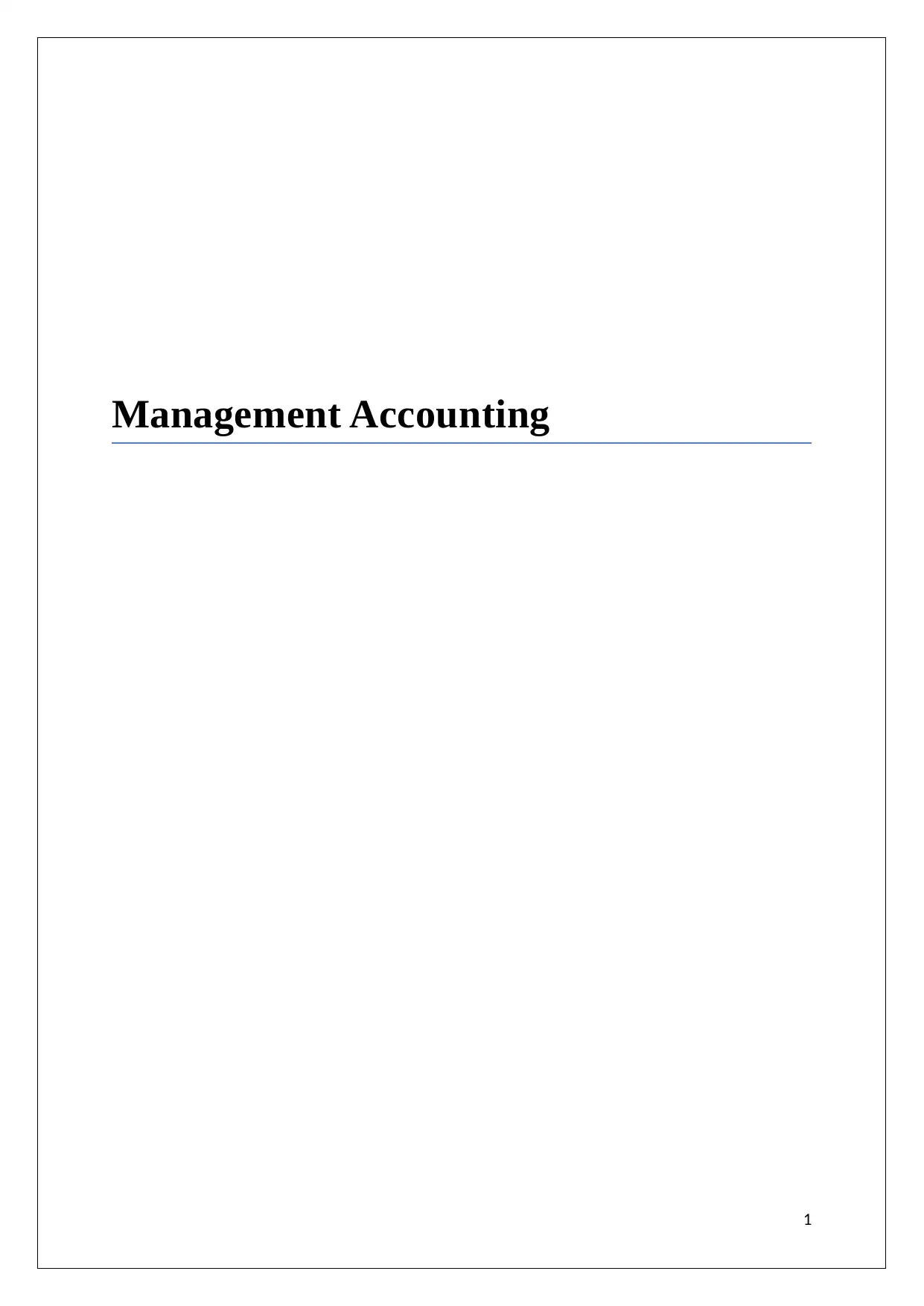
Management Accounting
1
1
Paraphrase This Document
Need a fresh take? Get an instant paraphrase of this document with our AI Paraphraser
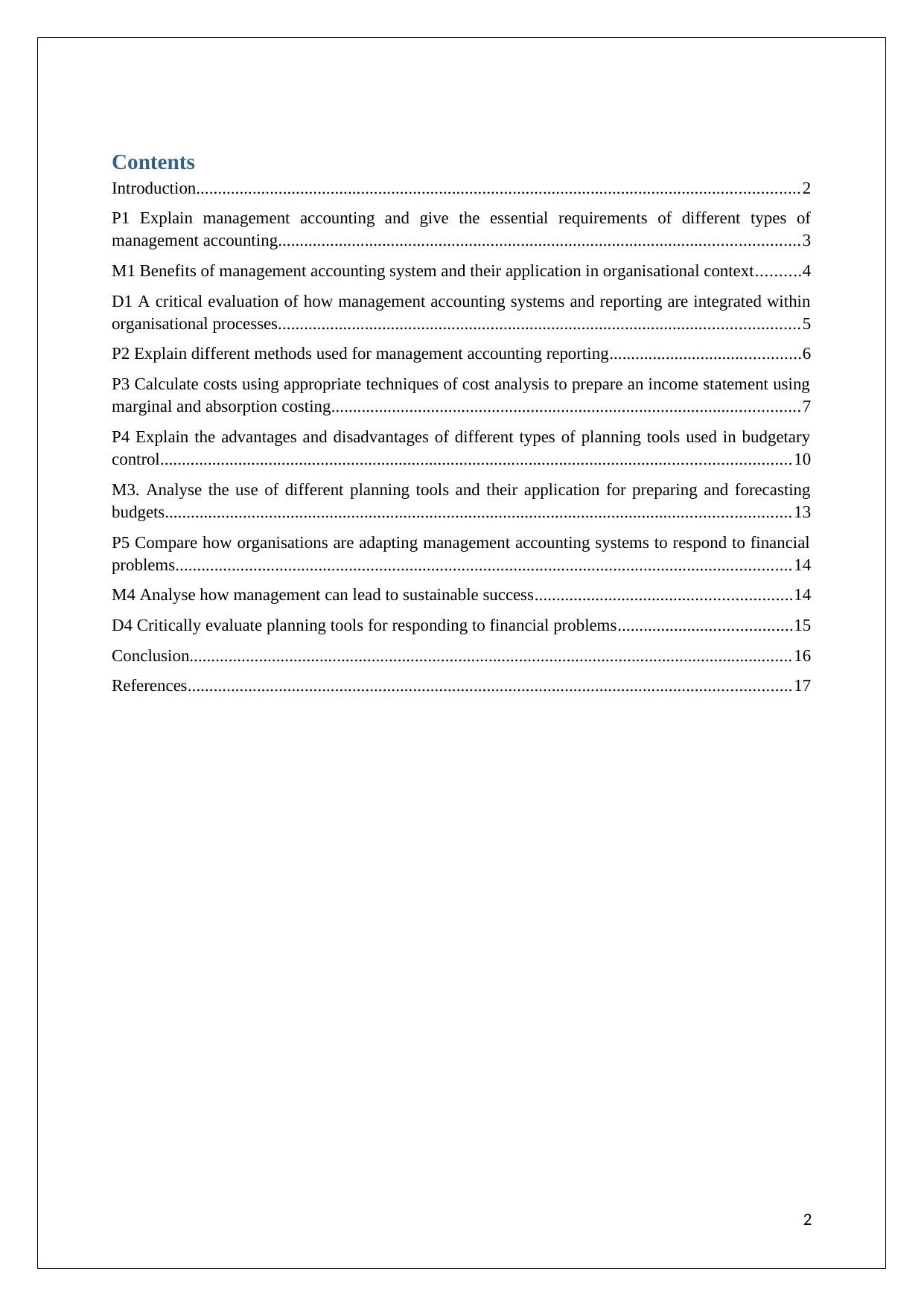
Contents
Introduction...........................................................................................................................................2
P1 Explain management accounting and give the essential requirements of different types of
management accounting........................................................................................................................3
M1 Benefits of management accounting system and their application in organisational context..........4
D1 A critical evaluation of how management accounting systems and reporting are integrated within
organisational processes........................................................................................................................5
P2 Explain different methods used for management accounting reporting............................................6
P3 Calculate costs using appropriate techniques of cost analysis to prepare an income statement using
marginal and absorption costing............................................................................................................7
P4 Explain the advantages and disadvantages of different types of planning tools used in budgetary
control.................................................................................................................................................10
M3. Analyse the use of different planning tools and their application for preparing and forecasting
budgets................................................................................................................................................13
P5 Compare how organisations are adapting management accounting systems to respond to financial
problems..............................................................................................................................................14
M4 Analyse how management can lead to sustainable success...........................................................14
D4 Critically evaluate planning tools for responding to financial problems........................................15
Conclusion...........................................................................................................................................16
References...........................................................................................................................................17
2
Introduction...........................................................................................................................................2
P1 Explain management accounting and give the essential requirements of different types of
management accounting........................................................................................................................3
M1 Benefits of management accounting system and their application in organisational context..........4
D1 A critical evaluation of how management accounting systems and reporting are integrated within
organisational processes........................................................................................................................5
P2 Explain different methods used for management accounting reporting............................................6
P3 Calculate costs using appropriate techniques of cost analysis to prepare an income statement using
marginal and absorption costing............................................................................................................7
P4 Explain the advantages and disadvantages of different types of planning tools used in budgetary
control.................................................................................................................................................10
M3. Analyse the use of different planning tools and their application for preparing and forecasting
budgets................................................................................................................................................13
P5 Compare how organisations are adapting management accounting systems to respond to financial
problems..............................................................................................................................................14
M4 Analyse how management can lead to sustainable success...........................................................14
D4 Critically evaluate planning tools for responding to financial problems........................................15
Conclusion...........................................................................................................................................16
References...........................................................................................................................................17
2
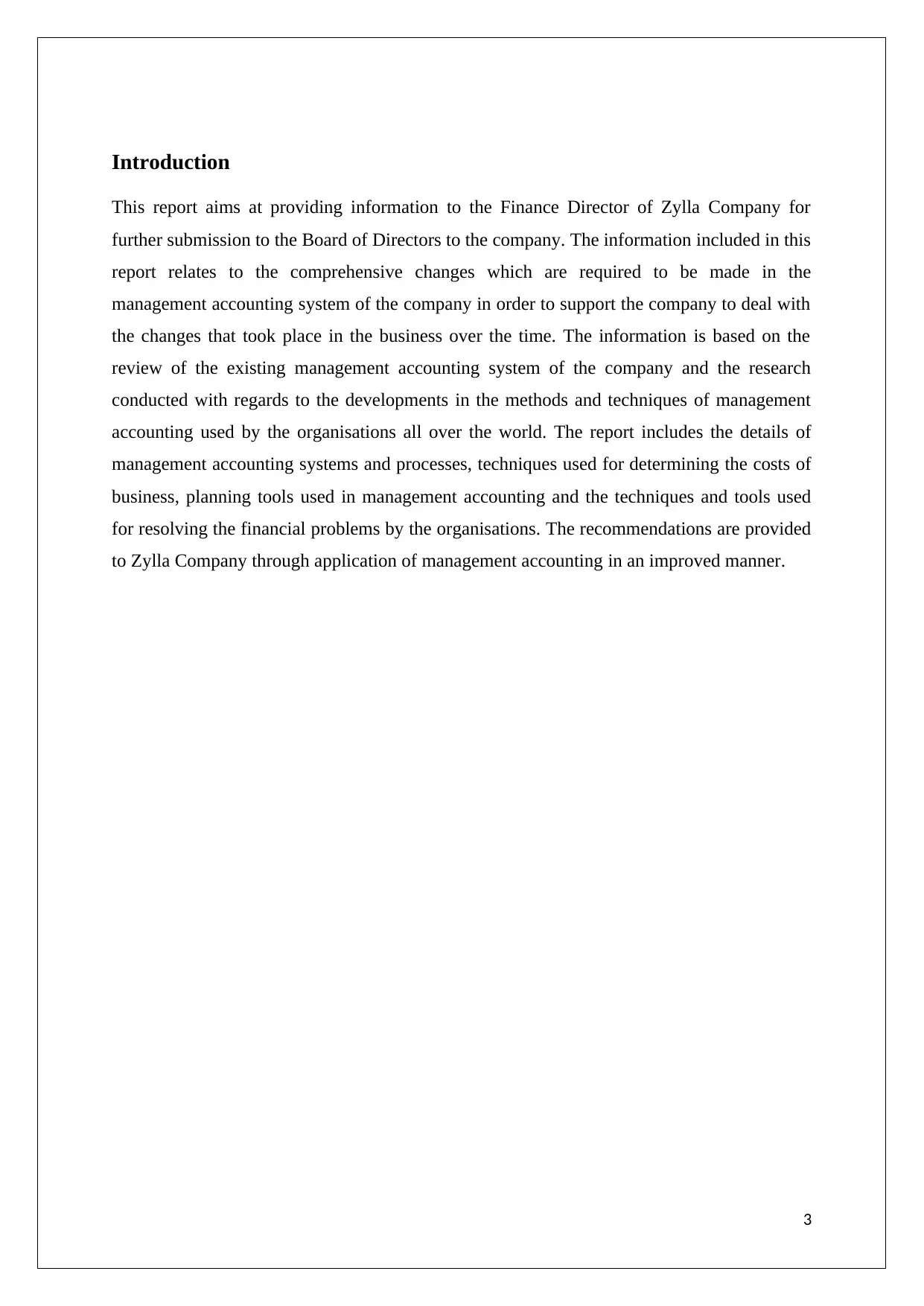
Introduction
This report aims at providing information to the Finance Director of Zylla Company for
further submission to the Board of Directors to the company. The information included in this
report relates to the comprehensive changes which are required to be made in the
management accounting system of the company in order to support the company to deal with
the changes that took place in the business over the time. The information is based on the
review of the existing management accounting system of the company and the research
conducted with regards to the developments in the methods and techniques of management
accounting used by the organisations all over the world. The report includes the details of
management accounting systems and processes, techniques used for determining the costs of
business, planning tools used in management accounting and the techniques and tools used
for resolving the financial problems by the organisations. The recommendations are provided
to Zylla Company through application of management accounting in an improved manner.
3
This report aims at providing information to the Finance Director of Zylla Company for
further submission to the Board of Directors to the company. The information included in this
report relates to the comprehensive changes which are required to be made in the
management accounting system of the company in order to support the company to deal with
the changes that took place in the business over the time. The information is based on the
review of the existing management accounting system of the company and the research
conducted with regards to the developments in the methods and techniques of management
accounting used by the organisations all over the world. The report includes the details of
management accounting systems and processes, techniques used for determining the costs of
business, planning tools used in management accounting and the techniques and tools used
for resolving the financial problems by the organisations. The recommendations are provided
to Zylla Company through application of management accounting in an improved manner.
3
⊘ This is a preview!⊘
Do you want full access?
Subscribe today to unlock all pages.

Trusted by 1+ million students worldwide
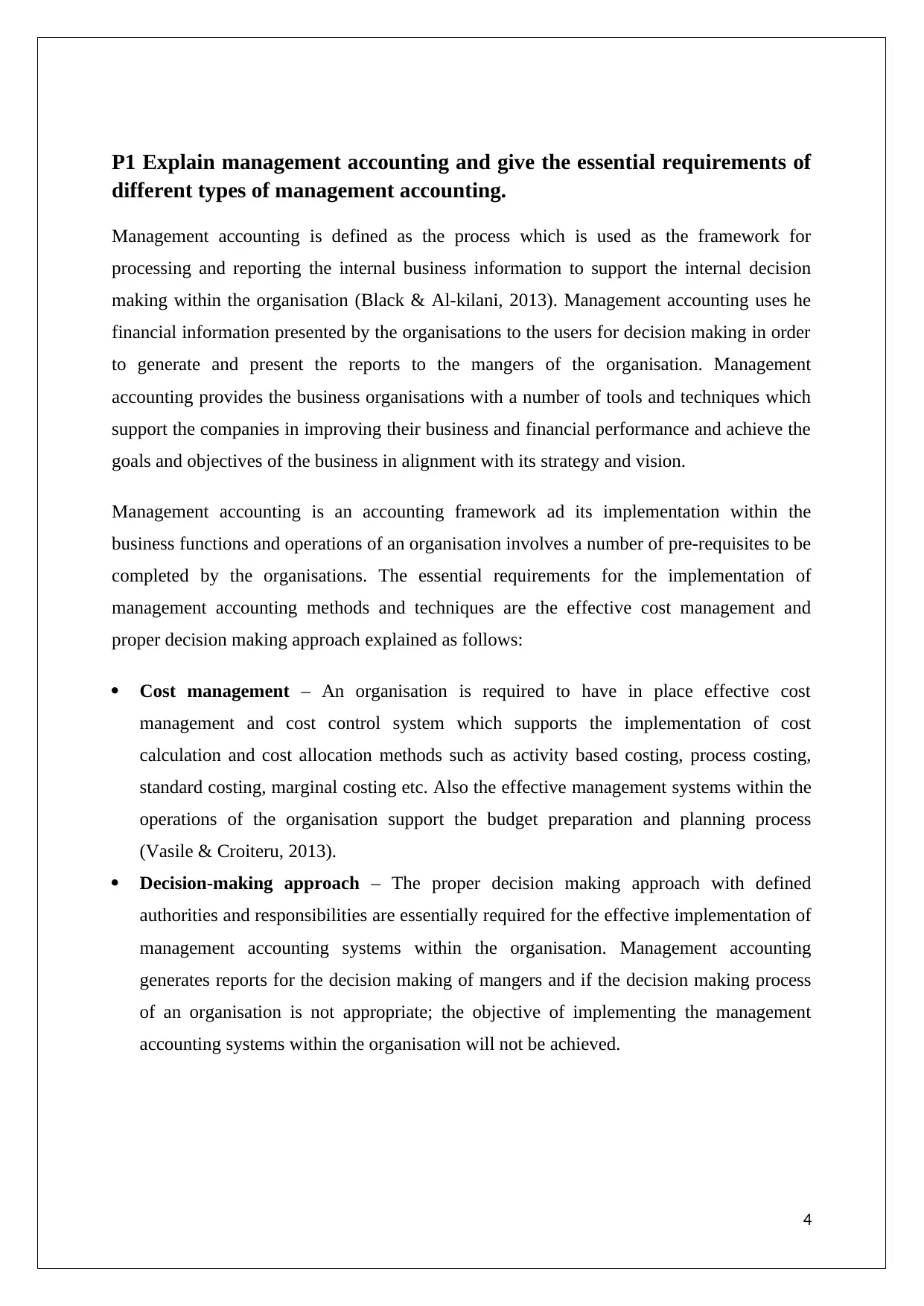
P1 Explain management accounting and give the essential requirements of
different types of management accounting.
Management accounting is defined as the process which is used as the framework for
processing and reporting the internal business information to support the internal decision
making within the organisation (Black & Al-kilani, 2013). Management accounting uses he
financial information presented by the organisations to the users for decision making in order
to generate and present the reports to the mangers of the organisation. Management
accounting provides the business organisations with a number of tools and techniques which
support the companies in improving their business and financial performance and achieve the
goals and objectives of the business in alignment with its strategy and vision.
Management accounting is an accounting framework ad its implementation within the
business functions and operations of an organisation involves a number of pre-requisites to be
completed by the organisations. The essential requirements for the implementation of
management accounting methods and techniques are the effective cost management and
proper decision making approach explained as follows:
Cost management – An organisation is required to have in place effective cost
management and cost control system which supports the implementation of cost
calculation and cost allocation methods such as activity based costing, process costing,
standard costing, marginal costing etc. Also the effective management systems within the
operations of the organisation support the budget preparation and planning process
(Vasile & Croiteru, 2013).
Decision-making approach – The proper decision making approach with defined
authorities and responsibilities are essentially required for the effective implementation of
management accounting systems within the organisation. Management accounting
generates reports for the decision making of mangers and if the decision making process
of an organisation is not appropriate; the objective of implementing the management
accounting systems within the organisation will not be achieved.
4
different types of management accounting.
Management accounting is defined as the process which is used as the framework for
processing and reporting the internal business information to support the internal decision
making within the organisation (Black & Al-kilani, 2013). Management accounting uses he
financial information presented by the organisations to the users for decision making in order
to generate and present the reports to the mangers of the organisation. Management
accounting provides the business organisations with a number of tools and techniques which
support the companies in improving their business and financial performance and achieve the
goals and objectives of the business in alignment with its strategy and vision.
Management accounting is an accounting framework ad its implementation within the
business functions and operations of an organisation involves a number of pre-requisites to be
completed by the organisations. The essential requirements for the implementation of
management accounting methods and techniques are the effective cost management and
proper decision making approach explained as follows:
Cost management – An organisation is required to have in place effective cost
management and cost control system which supports the implementation of cost
calculation and cost allocation methods such as activity based costing, process costing,
standard costing, marginal costing etc. Also the effective management systems within the
operations of the organisation support the budget preparation and planning process
(Vasile & Croiteru, 2013).
Decision-making approach – The proper decision making approach with defined
authorities and responsibilities are essentially required for the effective implementation of
management accounting systems within the organisation. Management accounting
generates reports for the decision making of mangers and if the decision making process
of an organisation is not appropriate; the objective of implementing the management
accounting systems within the organisation will not be achieved.
4
Paraphrase This Document
Need a fresh take? Get an instant paraphrase of this document with our AI Paraphraser
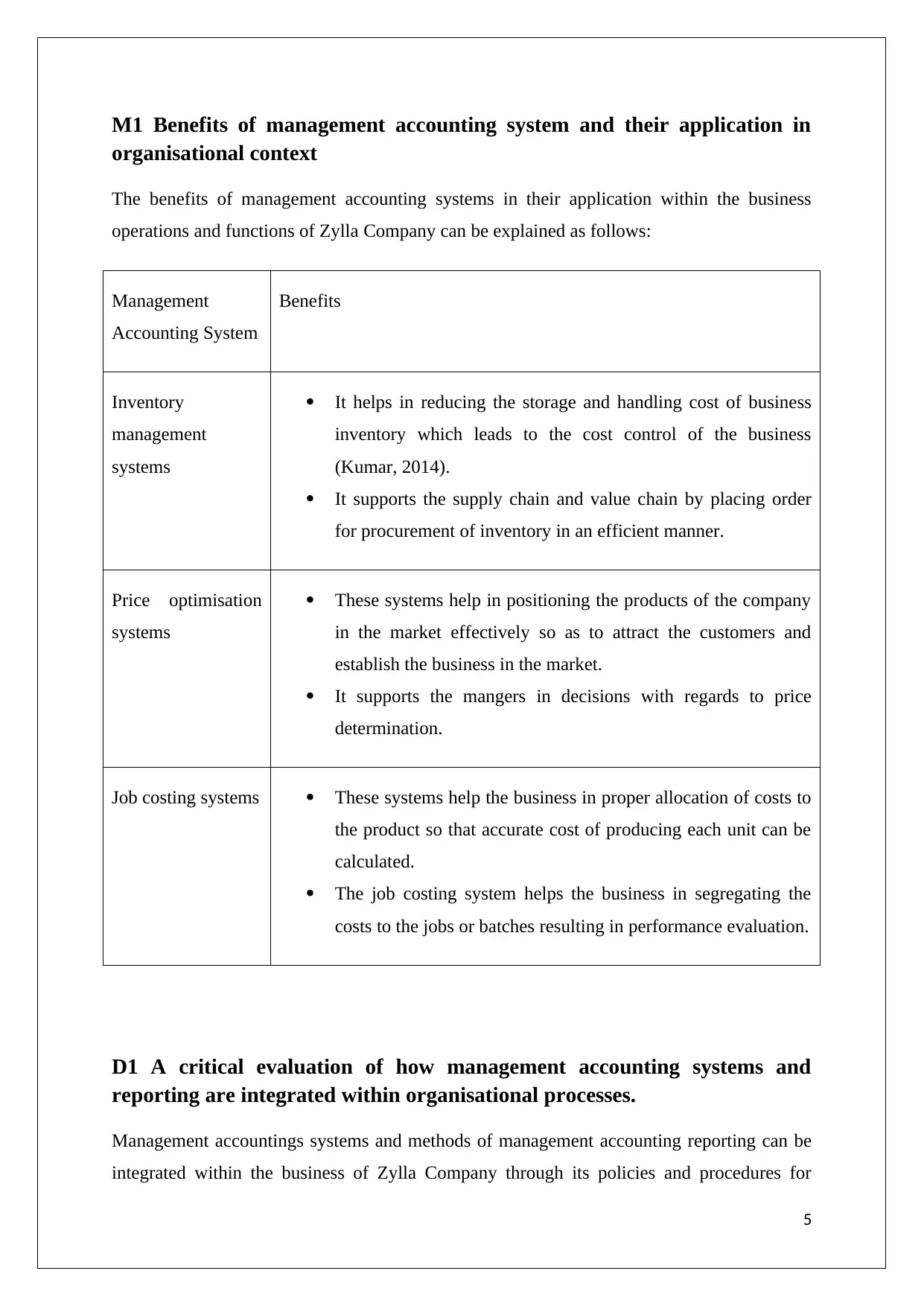
M1 Benefits of management accounting system and their application in
organisational context
The benefits of management accounting systems in their application within the business
operations and functions of Zylla Company can be explained as follows:
Management
Accounting System
Benefits
Inventory
management
systems
It helps in reducing the storage and handling cost of business
inventory which leads to the cost control of the business
(Kumar, 2014).
It supports the supply chain and value chain by placing order
for procurement of inventory in an efficient manner.
Price optimisation
systems
These systems help in positioning the products of the company
in the market effectively so as to attract the customers and
establish the business in the market.
It supports the mangers in decisions with regards to price
determination.
Job costing systems These systems help the business in proper allocation of costs to
the product so that accurate cost of producing each unit can be
calculated.
The job costing system helps the business in segregating the
costs to the jobs or batches resulting in performance evaluation.
D1 A critical evaluation of how management accounting systems and
reporting are integrated within organisational processes.
Management accountings systems and methods of management accounting reporting can be
integrated within the business of Zylla Company through its policies and procedures for
5
organisational context
The benefits of management accounting systems in their application within the business
operations and functions of Zylla Company can be explained as follows:
Management
Accounting System
Benefits
Inventory
management
systems
It helps in reducing the storage and handling cost of business
inventory which leads to the cost control of the business
(Kumar, 2014).
It supports the supply chain and value chain by placing order
for procurement of inventory in an efficient manner.
Price optimisation
systems
These systems help in positioning the products of the company
in the market effectively so as to attract the customers and
establish the business in the market.
It supports the mangers in decisions with regards to price
determination.
Job costing systems These systems help the business in proper allocation of costs to
the product so that accurate cost of producing each unit can be
calculated.
The job costing system helps the business in segregating the
costs to the jobs or batches resulting in performance evaluation.
D1 A critical evaluation of how management accounting systems and
reporting are integrated within organisational processes.
Management accountings systems and methods of management accounting reporting can be
integrated within the business of Zylla Company through its policies and procedures for
5
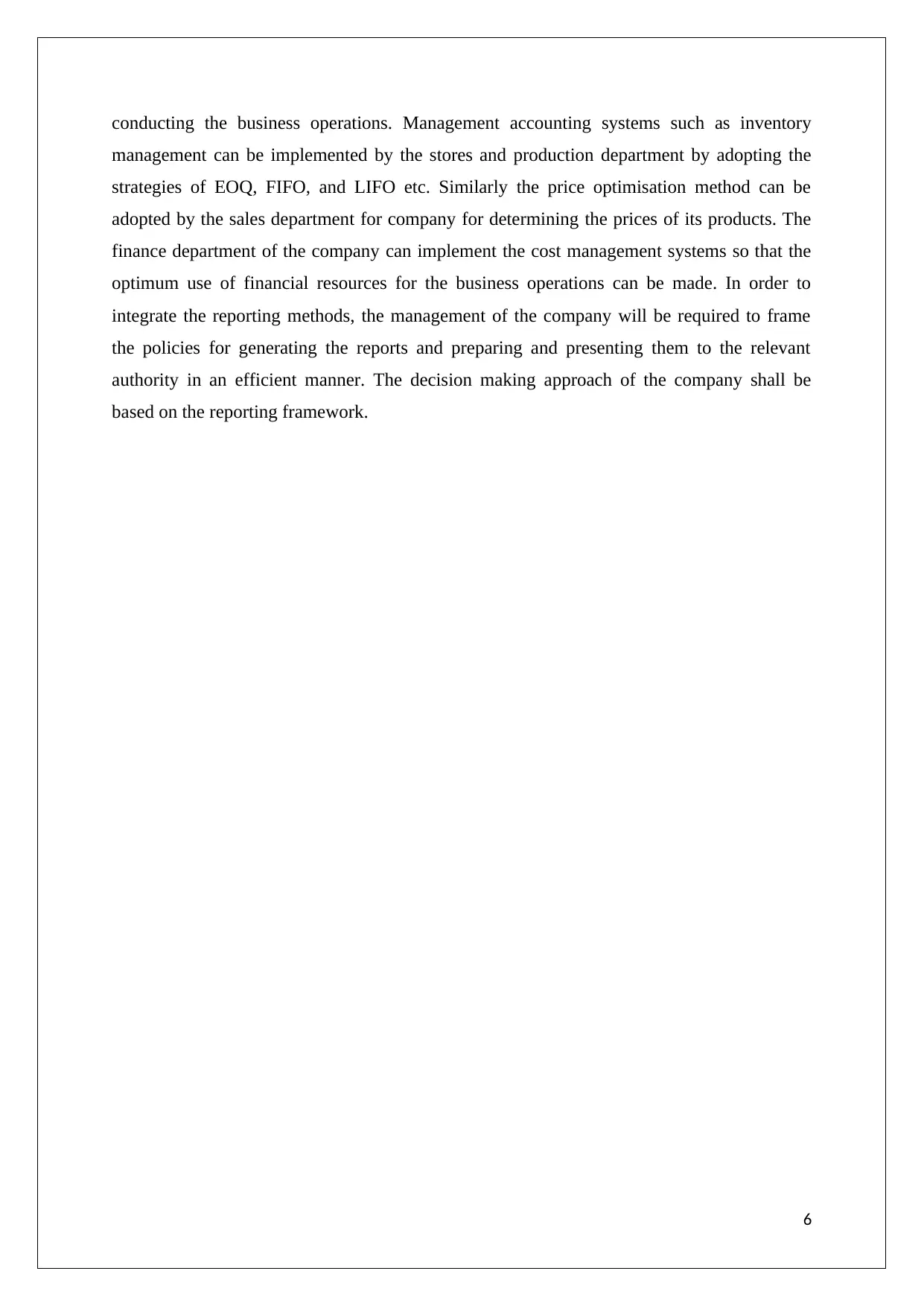
conducting the business operations. Management accounting systems such as inventory
management can be implemented by the stores and production department by adopting the
strategies of EOQ, FIFO, and LIFO etc. Similarly the price optimisation method can be
adopted by the sales department for company for determining the prices of its products. The
finance department of the company can implement the cost management systems so that the
optimum use of financial resources for the business operations can be made. In order to
integrate the reporting methods, the management of the company will be required to frame
the policies for generating the reports and preparing and presenting them to the relevant
authority in an efficient manner. The decision making approach of the company shall be
based on the reporting framework.
6
management can be implemented by the stores and production department by adopting the
strategies of EOQ, FIFO, and LIFO etc. Similarly the price optimisation method can be
adopted by the sales department for company for determining the prices of its products. The
finance department of the company can implement the cost management systems so that the
optimum use of financial resources for the business operations can be made. In order to
integrate the reporting methods, the management of the company will be required to frame
the policies for generating the reports and preparing and presenting them to the relevant
authority in an efficient manner. The decision making approach of the company shall be
based on the reporting framework.
6
⊘ This is a preview!⊘
Do you want full access?
Subscribe today to unlock all pages.

Trusted by 1+ million students worldwide
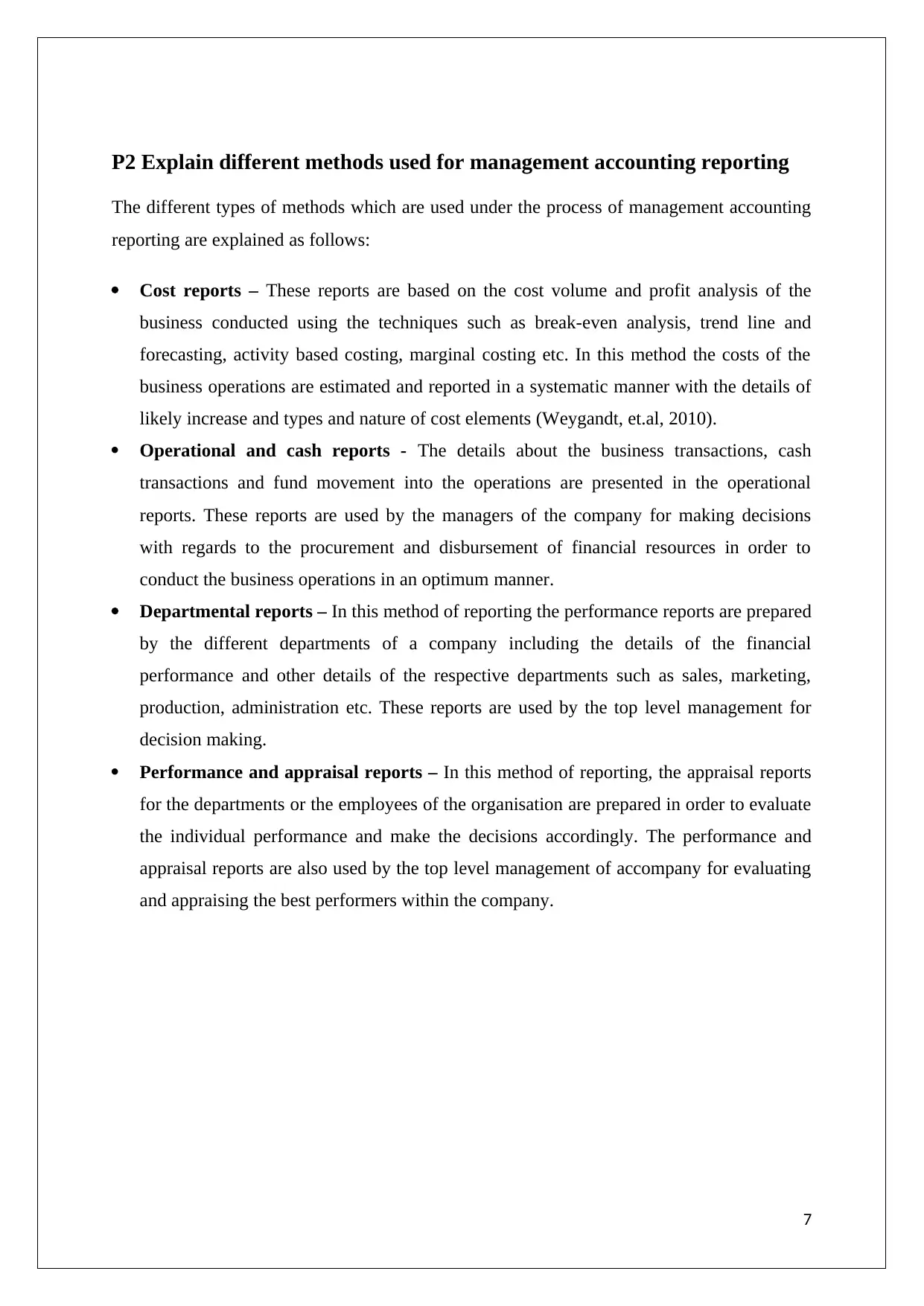
P2 Explain different methods used for management accounting reporting
The different types of methods which are used under the process of management accounting
reporting are explained as follows:
Cost reports – These reports are based on the cost volume and profit analysis of the
business conducted using the techniques such as break-even analysis, trend line and
forecasting, activity based costing, marginal costing etc. In this method the costs of the
business operations are estimated and reported in a systematic manner with the details of
likely increase and types and nature of cost elements (Weygandt, et.al, 2010).
Operational and cash reports - The details about the business transactions, cash
transactions and fund movement into the operations are presented in the operational
reports. These reports are used by the managers of the company for making decisions
with regards to the procurement and disbursement of financial resources in order to
conduct the business operations in an optimum manner.
Departmental reports – In this method of reporting the performance reports are prepared
by the different departments of a company including the details of the financial
performance and other details of the respective departments such as sales, marketing,
production, administration etc. These reports are used by the top level management for
decision making.
Performance and appraisal reports – In this method of reporting, the appraisal reports
for the departments or the employees of the organisation are prepared in order to evaluate
the individual performance and make the decisions accordingly. The performance and
appraisal reports are also used by the top level management of accompany for evaluating
and appraising the best performers within the company.
7
The different types of methods which are used under the process of management accounting
reporting are explained as follows:
Cost reports – These reports are based on the cost volume and profit analysis of the
business conducted using the techniques such as break-even analysis, trend line and
forecasting, activity based costing, marginal costing etc. In this method the costs of the
business operations are estimated and reported in a systematic manner with the details of
likely increase and types and nature of cost elements (Weygandt, et.al, 2010).
Operational and cash reports - The details about the business transactions, cash
transactions and fund movement into the operations are presented in the operational
reports. These reports are used by the managers of the company for making decisions
with regards to the procurement and disbursement of financial resources in order to
conduct the business operations in an optimum manner.
Departmental reports – In this method of reporting the performance reports are prepared
by the different departments of a company including the details of the financial
performance and other details of the respective departments such as sales, marketing,
production, administration etc. These reports are used by the top level management for
decision making.
Performance and appraisal reports – In this method of reporting, the appraisal reports
for the departments or the employees of the organisation are prepared in order to evaluate
the individual performance and make the decisions accordingly. The performance and
appraisal reports are also used by the top level management of accompany for evaluating
and appraising the best performers within the company.
7
Paraphrase This Document
Need a fresh take? Get an instant paraphrase of this document with our AI Paraphraser
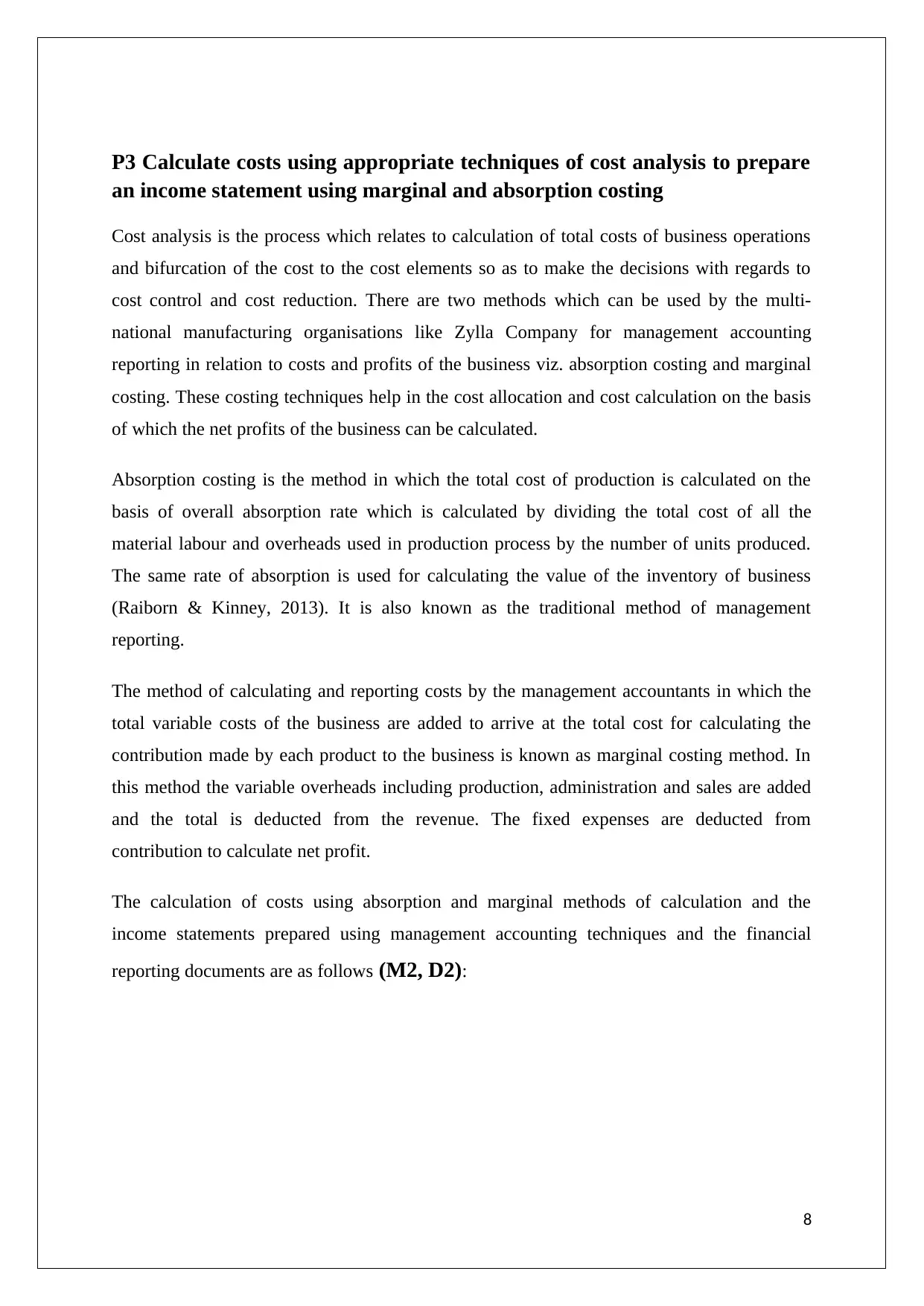
P3 Calculate costs using appropriate techniques of cost analysis to prepare
an income statement using marginal and absorption costing
Cost analysis is the process which relates to calculation of total costs of business operations
and bifurcation of the cost to the cost elements so as to make the decisions with regards to
cost control and cost reduction. There are two methods which can be used by the multi-
national manufacturing organisations like Zylla Company for management accounting
reporting in relation to costs and profits of the business viz. absorption costing and marginal
costing. These costing techniques help in the cost allocation and cost calculation on the basis
of which the net profits of the business can be calculated.
Absorption costing is the method in which the total cost of production is calculated on the
basis of overall absorption rate which is calculated by dividing the total cost of all the
material labour and overheads used in production process by the number of units produced.
The same rate of absorption is used for calculating the value of the inventory of business
(Raiborn & Kinney, 2013). It is also known as the traditional method of management
reporting.
The method of calculating and reporting costs by the management accountants in which the
total variable costs of the business are added to arrive at the total cost for calculating the
contribution made by each product to the business is known as marginal costing method. In
this method the variable overheads including production, administration and sales are added
and the total is deducted from the revenue. The fixed expenses are deducted from
contribution to calculate net profit.
The calculation of costs using absorption and marginal methods of calculation and the
income statements prepared using management accounting techniques and the financial
reporting documents are as follows (M2, D2):
8
an income statement using marginal and absorption costing
Cost analysis is the process which relates to calculation of total costs of business operations
and bifurcation of the cost to the cost elements so as to make the decisions with regards to
cost control and cost reduction. There are two methods which can be used by the multi-
national manufacturing organisations like Zylla Company for management accounting
reporting in relation to costs and profits of the business viz. absorption costing and marginal
costing. These costing techniques help in the cost allocation and cost calculation on the basis
of which the net profits of the business can be calculated.
Absorption costing is the method in which the total cost of production is calculated on the
basis of overall absorption rate which is calculated by dividing the total cost of all the
material labour and overheads used in production process by the number of units produced.
The same rate of absorption is used for calculating the value of the inventory of business
(Raiborn & Kinney, 2013). It is also known as the traditional method of management
reporting.
The method of calculating and reporting costs by the management accountants in which the
total variable costs of the business are added to arrive at the total cost for calculating the
contribution made by each product to the business is known as marginal costing method. In
this method the variable overheads including production, administration and sales are added
and the total is deducted from the revenue. The fixed expenses are deducted from
contribution to calculate net profit.
The calculation of costs using absorption and marginal methods of calculation and the
income statements prepared using management accounting techniques and the financial
reporting documents are as follows (M2, D2):
8
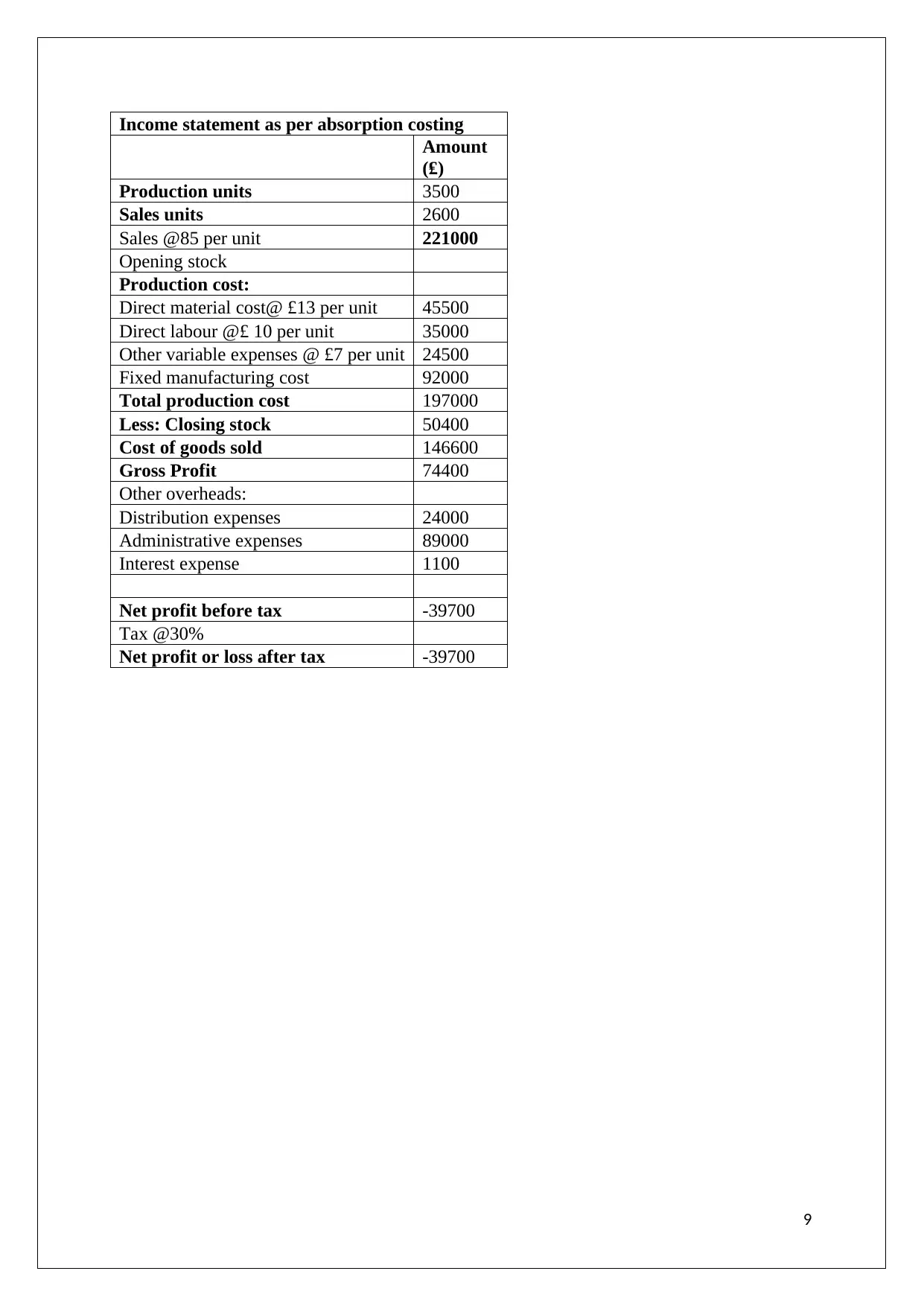
Income statement as per absorption costing
Amount
(₤)
Production units 3500
Sales units 2600
Sales @85 per unit 221000
Opening stock
Production cost:
Direct material cost@ £13 per unit 45500
Direct labour @£ 10 per unit 35000
Other variable expenses @ £7 per unit 24500
Fixed manufacturing cost 92000
Total production cost 197000
Less: Closing stock 50400
Cost of goods sold 146600
Gross Profit 74400
Other overheads:
Distribution expenses 24000
Administrative expenses 89000
Interest expense 1100
Net profit before tax -39700
Tax @30%
Net profit or loss after tax -39700
9
Amount
(₤)
Production units 3500
Sales units 2600
Sales @85 per unit 221000
Opening stock
Production cost:
Direct material cost@ £13 per unit 45500
Direct labour @£ 10 per unit 35000
Other variable expenses @ £7 per unit 24500
Fixed manufacturing cost 92000
Total production cost 197000
Less: Closing stock 50400
Cost of goods sold 146600
Gross Profit 74400
Other overheads:
Distribution expenses 24000
Administrative expenses 89000
Interest expense 1100
Net profit before tax -39700
Tax @30%
Net profit or loss after tax -39700
9
⊘ This is a preview!⊘
Do you want full access?
Subscribe today to unlock all pages.

Trusted by 1+ million students worldwide
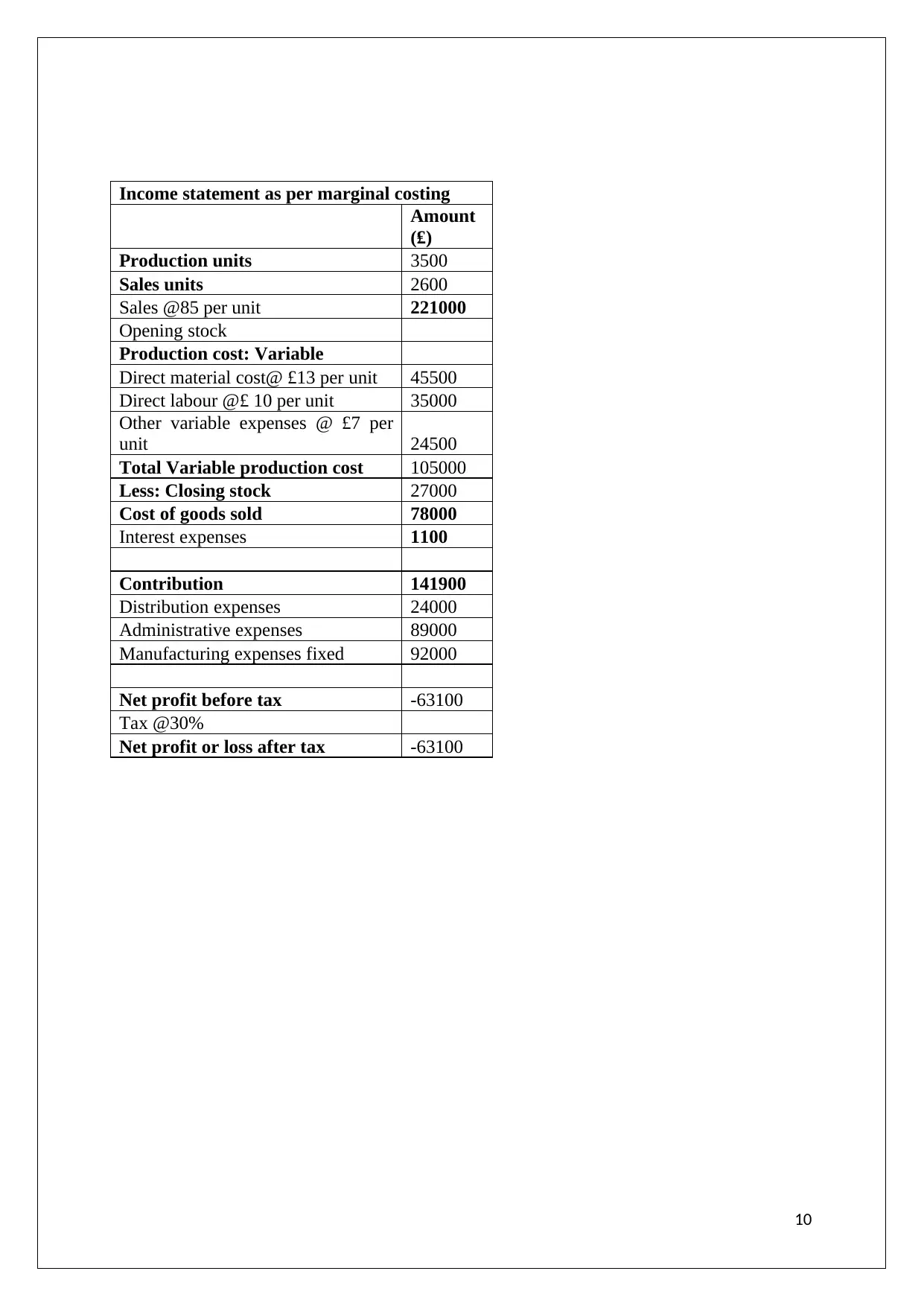
Income statement as per marginal costing
Amount
(₤)
Production units 3500
Sales units 2600
Sales @85 per unit 221000
Opening stock
Production cost: Variable
Direct material cost@ £13 per unit 45500
Direct labour @£ 10 per unit 35000
Other variable expenses @ £7 per
unit 24500
Total Variable production cost 105000
Less: Closing stock 27000
Cost of goods sold 78000
Interest expenses 1100
Contribution 141900
Distribution expenses 24000
Administrative expenses 89000
Manufacturing expenses fixed 92000
Net profit before tax -63100
Tax @30%
Net profit or loss after tax -63100
10
Amount
(₤)
Production units 3500
Sales units 2600
Sales @85 per unit 221000
Opening stock
Production cost: Variable
Direct material cost@ £13 per unit 45500
Direct labour @£ 10 per unit 35000
Other variable expenses @ £7 per
unit 24500
Total Variable production cost 105000
Less: Closing stock 27000
Cost of goods sold 78000
Interest expenses 1100
Contribution 141900
Distribution expenses 24000
Administrative expenses 89000
Manufacturing expenses fixed 92000
Net profit before tax -63100
Tax @30%
Net profit or loss after tax -63100
10
Paraphrase This Document
Need a fresh take? Get an instant paraphrase of this document with our AI Paraphraser
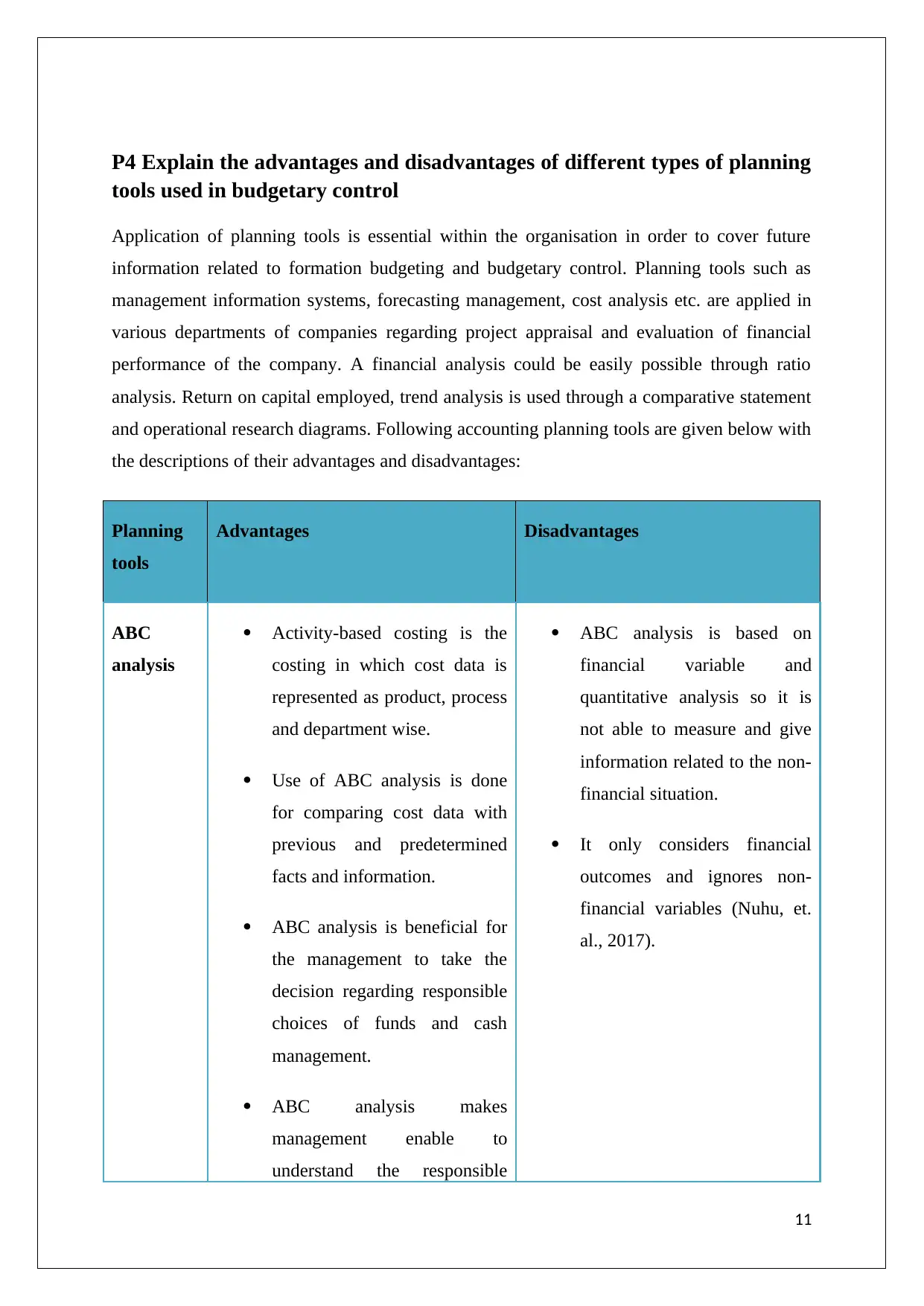
P4 Explain the advantages and disadvantages of different types of planning
tools used in budgetary control
Application of planning tools is essential within the organisation in order to cover future
information related to formation budgeting and budgetary control. Planning tools such as
management information systems, forecasting management, cost analysis etc. are applied in
various departments of companies regarding project appraisal and evaluation of financial
performance of the company. A financial analysis could be easily possible through ratio
analysis. Return on capital employed, trend analysis is used through a comparative statement
and operational research diagrams. Following accounting planning tools are given below with
the descriptions of their advantages and disadvantages:
Planning
tools
Advantages Disadvantages
ABC
analysis
Activity-based costing is the
costing in which cost data is
represented as product, process
and department wise.
Use of ABC analysis is done
for comparing cost data with
previous and predetermined
facts and information.
ABC analysis is beneficial for
the management to take the
decision regarding responsible
choices of funds and cash
management.
ABC analysis makes
management enable to
understand the responsible
ABC analysis is based on
financial variable and
quantitative analysis so it is
not able to measure and give
information related to the non-
financial situation.
It only considers financial
outcomes and ignores non-
financial variables (Nuhu, et.
al., 2017).
11
tools used in budgetary control
Application of planning tools is essential within the organisation in order to cover future
information related to formation budgeting and budgetary control. Planning tools such as
management information systems, forecasting management, cost analysis etc. are applied in
various departments of companies regarding project appraisal and evaluation of financial
performance of the company. A financial analysis could be easily possible through ratio
analysis. Return on capital employed, trend analysis is used through a comparative statement
and operational research diagrams. Following accounting planning tools are given below with
the descriptions of their advantages and disadvantages:
Planning
tools
Advantages Disadvantages
ABC
analysis
Activity-based costing is the
costing in which cost data is
represented as product, process
and department wise.
Use of ABC analysis is done
for comparing cost data with
previous and predetermined
facts and information.
ABC analysis is beneficial for
the management to take the
decision regarding responsible
choices of funds and cash
management.
ABC analysis makes
management enable to
understand the responsible
ABC analysis is based on
financial variable and
quantitative analysis so it is
not able to measure and give
information related to the non-
financial situation.
It only considers financial
outcomes and ignores non-
financial variables (Nuhu, et.
al., 2017).
11
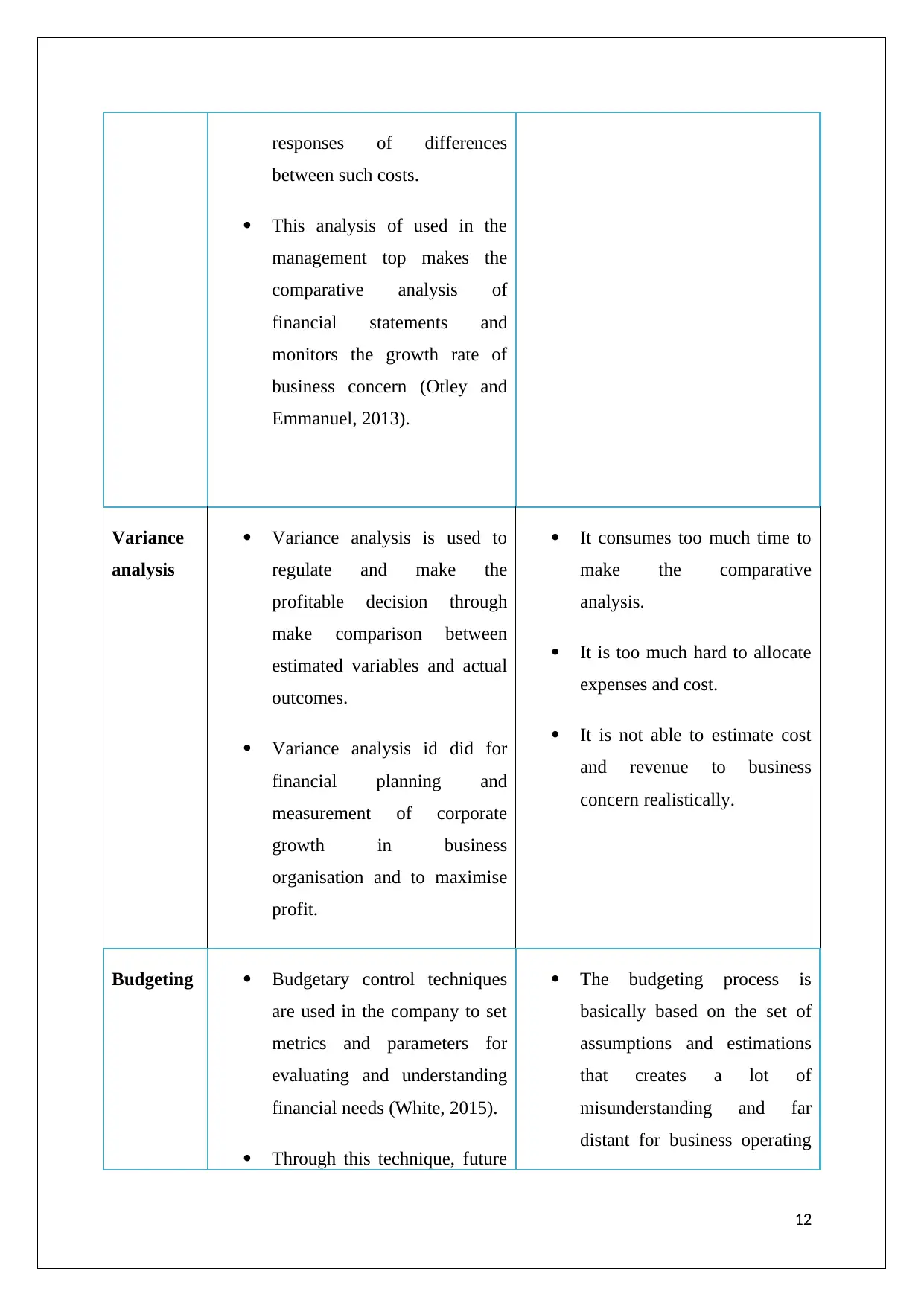
responses of differences
between such costs.
This analysis of used in the
management top makes the
comparative analysis of
financial statements and
monitors the growth rate of
business concern (Otley and
Emmanuel, 2013).
Variance
analysis
Variance analysis is used to
regulate and make the
profitable decision through
make comparison between
estimated variables and actual
outcomes.
Variance analysis id did for
financial planning and
measurement of corporate
growth in business
organisation and to maximise
profit.
It consumes too much time to
make the comparative
analysis.
It is too much hard to allocate
expenses and cost.
It is not able to estimate cost
and revenue to business
concern realistically.
Budgeting Budgetary control techniques
are used in the company to set
metrics and parameters for
evaluating and understanding
financial needs (White, 2015).
Through this technique, future
The budgeting process is
basically based on the set of
assumptions and estimations
that creates a lot of
misunderstanding and far
distant for business operating
12
between such costs.
This analysis of used in the
management top makes the
comparative analysis of
financial statements and
monitors the growth rate of
business concern (Otley and
Emmanuel, 2013).
Variance
analysis
Variance analysis is used to
regulate and make the
profitable decision through
make comparison between
estimated variables and actual
outcomes.
Variance analysis id did for
financial planning and
measurement of corporate
growth in business
organisation and to maximise
profit.
It consumes too much time to
make the comparative
analysis.
It is too much hard to allocate
expenses and cost.
It is not able to estimate cost
and revenue to business
concern realistically.
Budgeting Budgetary control techniques
are used in the company to set
metrics and parameters for
evaluating and understanding
financial needs (White, 2015).
Through this technique, future
The budgeting process is
basically based on the set of
assumptions and estimations
that creates a lot of
misunderstanding and far
distant for business operating
12
⊘ This is a preview!⊘
Do you want full access?
Subscribe today to unlock all pages.

Trusted by 1+ million students worldwide
1 out of 19
Related Documents
Your All-in-One AI-Powered Toolkit for Academic Success.
+13062052269
info@desklib.com
Available 24*7 on WhatsApp / Email
![[object Object]](/_next/static/media/star-bottom.7253800d.svg)
Unlock your academic potential
Copyright © 2020–2025 A2Z Services. All Rights Reserved. Developed and managed by ZUCOL.





